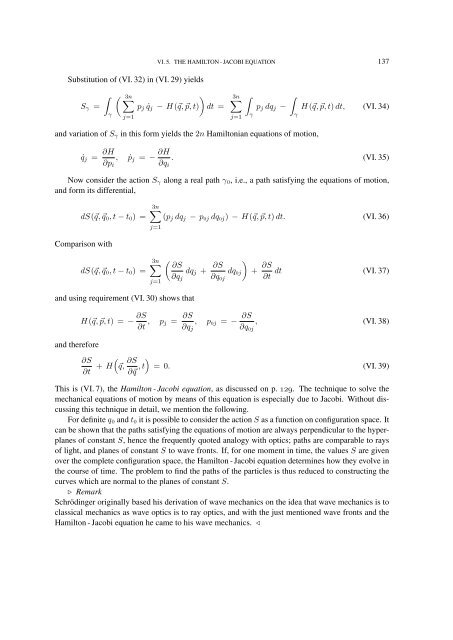FOUNDATIONS OF QUANTUM MECHANICS
FOUNDATIONS OF QUANTUM MECHANICS
FOUNDATIONS OF QUANTUM MECHANICS
You also want an ePaper? Increase the reach of your titles
YUMPU automatically turns print PDFs into web optimized ePapers that Google loves.
VI. 5. THE HAMILTON - JACOBI EQUATION 137<br />
Substitution of (VI. 32) in (VI. 29) yields<br />
S γ =<br />
∫<br />
γ<br />
( 3n∑<br />
j=1<br />
)<br />
p j ˙q j − H (⃗q, ⃗p, t) dt =<br />
3n∑<br />
j=1<br />
∫<br />
γ<br />
p j dq j −<br />
∫<br />
γ<br />
H (⃗q, ⃗p, t) dt, (VI. 34)<br />
and variation of S γ in this form yields the 2n Hamiltonian equations of motion,<br />
˙q j = ∂H<br />
∂p i<br />
,<br />
ṗ j = − ∂H<br />
∂q i<br />
. (VI. 35)<br />
Now consider the action S γ along a real path γ 0 , i.e., a path satisfying the equations of motion,<br />
and form its differential,<br />
dS(⃗q, ⃗q 0 , t − t 0 ) =<br />
3n∑<br />
j=1<br />
(p j dq j − p 0j dq 0j ) − H (⃗q, ⃗p, t) dt. (VI. 36)<br />
Comparison with<br />
dS(⃗q, ⃗q 0 , t − t 0 ) =<br />
3n∑<br />
j=1<br />
( ∂S<br />
∂q j<br />
dq j +<br />
∂S )<br />
dq 0j + ∂S dt (VI. 37)<br />
∂q 0j ∂t<br />
and using requirement (VI. 30) shows that<br />
H (⃗q, ⃗p, t) = − ∂S<br />
∂t ,<br />
p j = ∂S<br />
∂q j<br />
,<br />
p 0j = − ∂S<br />
∂q 0j<br />
, (VI. 38)<br />
and therefore<br />
∂S<br />
(<br />
∂t + H ⃗q, ∂S )<br />
∂⃗q , t<br />
= 0. (VI. 39)<br />
This is (VI. 7), the Hamilton - Jacobi equation, as discussed on p. 129. The technique to solve the<br />
mechanical equations of motion by means of this equation is especially due to Jacobi. Without discussing<br />
this technique in detail, we mention the following.<br />
For definite q 0 and t 0 it is possible to consider the action S as a function on configuration space. It<br />
can be shown that the paths satisfying the equations of motion are always perpendicular to the hyperplanes<br />
of constant S, hence the frequently quoted analogy with optics; paths are comparable to rays<br />
of light, and planes of constant S to wave fronts. If, for one moment in time, the values S are given<br />
over the complete configuration space, the Hamilton - Jacobi equation determines how they evolve in<br />
the course of time. The problem to find the paths of the particles is thus reduced to constructing the<br />
curves which are normal to the planes of constant S.<br />
◃ Remark<br />
Schrödinger originally based his derivation of wave mechanics on the idea that wave mechanics is to<br />
classical mechanics as wave optics is to ray optics, and with the just mentioned wave fronts and the<br />
Hamilton - Jacobi equation he came to his wave mechanics. ▹
















